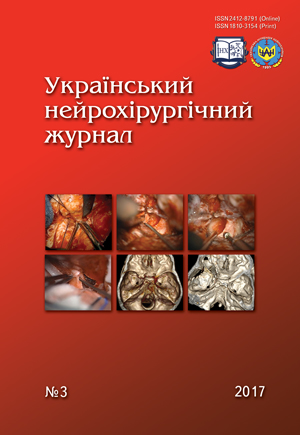Transcranial bony optic nerve decompression in surgical treatment of basal meningiomas
DOI:
https://doi.org/10.25305/unj.112105Keywords:
meningioma, optic nerve, sellar (parasellar) localization, optochiasmatic localization, surgical treatment, optic nerve decompression, anterior clinoidectomyAbstract
Background. Surgical treatment of basal meningioma has always been recognized as an important problem of neurosurgery. Tumor extension to the optic canal is considered to be the main factor limiting the radical removal of these tumors, on the one hand, and defining unsatisfactory functional results of surgical interventions, on the other hand. Therefore in current literature the key to the surgery of suprasellar meningioma extending into optic canal is the early extradural decompression of the optic nerve, its maximum mobilization before direct manipulation of the tumor. Large surgical series prove that this approach provides the basis for meningioma radical excision with preserving or improving impaired optical functions.
Aim. To improve treatment results in patients with basal meningiomas, which involve the optic canal and lead to visual deterioration.
Materials and methods. This study includes various optic nerve decompression (OND), with maximum optic canal decompression added by anterior clinoidectomy. The paper studies the question of rational of optic nerve decompression, its volume and technique. The paper analyzes the results of surgical treatment of 85 basal meningiomas in the sellar and parasellar region, which involved the optic canal and treated by BOND in different variantions. Males were 30 (35.3%), female 55 (64.7%). The average age was 54.6 ± 5.3 years. By the surgical intervention method the patients were divided into two clinical subgroups. The first subgroup consisted of patients with bony optic canal decompression (39 patients(45.9%)), the second subgroup included those without such manipulations (46 cases (54.1%)).
Results and discussion. The results of surgical treatment for visual functions were statistically significantly better in the subgroup of the patients undergone bony canal decompression. The choice of approach to the tumors in both groups was predetermined rather by topographic and anatomical peculiarities and meningioma size than the necessity of optic nerve decompression.
Conclusion. Optic canal decompression is an important step providing a good functional result of surgical treatment of the patient with supra and parasellar meningiomas.
References
1. Kalinin PL, Kutin MA, Fomichev DV, Kadashev BA, Grigor’eva NN, Tropinskaia OF, Faĭzullaev RB. [Changes in visual and oculomotor impairments after endoscopic endonasal transsphenoidal removal of pituitary adenomas]. Vestn Oftalmol. 2009 Jul-Aug;125(4):23-7. Russian. [PubMed]
2. Nozaki K, Kikuta K, Takagi Y, Mineharu Y, Takahashi JA, Hashimoto N. Effect of early optic canal unroofing on the outcome of visual functions in surgery for meningiomas of the tuberculum sellae and planum sphenoidale. Neurosurgery. 2008 Apr;62(4):839-44; discussion 844-6. [CrossRef] [PubMed]
3. Froelich SC, Aziz KM, Levine NB, Theodosopoulos PV, van Loveren HR, Keller JT. Refinement of the extradural anterior clinoidectomy: surgical anatomy of the orbitotemporal periosteal fold. Neurosurgery. 2007 Nov;61(5 Suppl 2):179-85; discussion 185-6. [CrossRef] [PubMed]
4. Mortini P, Barzaghi LR, Serra C, Orlandi V, Bianchi S, Losa M. Visual outcome after fronto-temporo-orbito-zygomatic approach combined with early extradural and intradural optic nerve decompression in tuberculum and diaphragma sellae meningiomas. Clin Neurol Neurosurg. 2012 Jul;114(6):597-606. [CrossRef] [PubMed]
5. Mortazavi MM, Brito da Silva H, Ferreira M Jr, Barber JK, Pridgeon JS, Sekhar LN. Planum Sphenoidale and Tuberculum Sellae Meningiomas: Operative Nuances of a Modern Surgical Technique with Outcome and Proposal of a New Classification System. World Neurosurg. 2016 Feb;86:270-86. [CrossRef] [PubMed]
6. Hakuba A, Tanaka K, Suzuki T, Nishimura S. A combined orbitozygomatic infratemporal epidural and subdural approach for lesions involving the entire cavernous sinus. J Neurosurg. 1989 Nov;71(5 Pt1):699-704. [CrossRef] [PubMed]
7. Al-Mefty O, Ayoubi S. Clinoidal Meningiomas. Acta Neurochirurgica Supplementum. Springer Vienna; 1991;92–7. [CrossRef]
8. Kutin MA, Kadashev BA, Kalinin PL, Serova NK, Tropinskaya OF, Andreev DN, Fomichev DV, Sharipov OI, Turkin AM, Shultz EI. [Assessment of optic nerve decompression efficiency in resection of sellar region meningiomas via intradural subfrontal approach]. Zh Vopr Neirokhir Im N N Burdenko. 2014;78(4):14-30. Russian. [PubMed]
9. Mariniello G, de Divitiis O, Bonavolontа G, Maiuri F. Surgical unroofing of the optic canal and visual outcome in basal meningiomas. Acta Neurochir (Wien). 2013 Jan;155(1):77-84. [CrossRef] [PubMed]
10. Mathiesen T, Kihlstrцm L. Visual outcome of tuberculum sellae meningiomas after extradural optic nerve decompression. Neurosurgery. 2006 Sep;59(3):570-6;discussion 570-6. [PubMed]
11. Lehmberg J, Krieg SM, Meyer B. Anterior clinoidectomy. Acta Neurochir (Wien). 2014 Feb;156(2):415-9; discussion 419. [CrossRef] [PubMed]
12. Taha AN, Erkmen K, Dunn IF, Pravdenkova S, Al-Mefty O. Meningiomas involving the optic canal: pattern of involvement and implications for surgical technique. Neurosurg Focus. 2011 May;30(5):E12. [CrossRef] [PubMed]
13. Dolenc VV. A combined epi- and subdural direct approach to carotid-ophthalmic artery aneurysms. J Neurosurg. 1985 May;62(5):667-72. [CrossRef] [PubMed]
Downloads
Published
How to Cite
Issue
Section
License
Copyright (c) 2017 Zinovii M. Nykyforak, Arthur O. Mumliev, Mykola O. Guk, Мichail S. Kvasha, Vasyl V. Kondratiuk, Valentyn M. Kliuchka

This work is licensed under a Creative Commons Attribution 4.0 International License.
Ukrainian Neurosurgical Journal abides by the CREATIVE COMMONS copyright rights and permissions for open access journals.
Authors, who are published in this Journal, agree to the following conditions:
1. The authors reserve the right to authorship of the work and pass the first publication right of this work to the Journal under the terms of Creative Commons Attribution License, which allows others to freely distribute the published research with the obligatory reference to the authors of the original work and the first publication of the work in this Journal.
2. The authors have the right to conclude separate supplement agreements that relate to non-exclusive work distribution in the form of which it has been published by the Journal (for example, to upload the work to the online storage of the Journal or publish it as part of a monograph), provided that the reference to the first publication of the work in this Journal is included.









